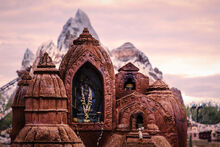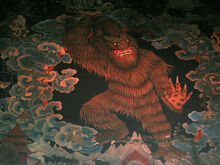The Yeti is a cryptid that lives in the Forbidden Mountain near Mount Everest. He is the antagonist of Expedition Everest at Disney’s Animal Kingdom.
Description[]
The yeti is a 25 foot-tall (hominid) primate which is native to the Forbidden Mountain of the Himalayas. It is unclear if it is purely an animal or if it has elements of magic in it though it does show adaptations similar to other animals which live in its ecosystem. It had feet which were roughly 1.12 metres (3.6') long and which were built similarly to those of an orangutang with prehensile big toes albeit with the rest of its toes being shorter.[1]
The yeti is covered in a thick coat of shaggy brown fur with some blue colourations around its skin. This fur is very yak-like and given their shared environment and similar extreme proportions, it is possible that the giant biology evolved conversantly with that of the yak so it could have larger internal-organs adapted to best controlling blood-flow in its low-oxygen alpine ecosystem.[2] Unlike most hominids, the yeti's nails were long, thick and sharpened like claws. The function of these claws is unknown but possible uses might include predation, digging, clasping for breeding and/or self-defence.
The blue facial colourations and flat, gaping nose of the yeti made it bare a resemblance to the snub-nosed monkey group of old world monkeys, some of which are known to have inhabited the Himalayas. However as the yeti is seemingly a hominid, it is unknown if it merely convergently evolved these specialized simian traits (likely due to sharing an ecosystem with the monkeys). The purpose for this snub-nose in the yeti is almost certainly to combat frost-bite in its cold environment.[3]
Given its sheer size and scarcity of food in its ecosystem, the diet of the yeti remains a mystery. The large incisors of the yeti seem to rule out any herbivorous diet though due to the scarce amount of food in the Himalayas, it is more likely that it would be an omnivore than a carnivore. Given its presumably similar niche to the Himalayan Black Bear, the yeti might have the same omnivorous diet as the bear which would include: bugs, nuts, rodents, roots and cattle such as yak, sheep or goats.[4]
Background[]
Real-Life[]
The Yeti had been a part of Tibetan folklore for centuries, traditionally named to: g.ya' dred, Yachê, and g.ya' which would later be anglicized as, "Yeti". Most traditional names referencing the creature being along the lines of a man/bear hybrid or giant bear, namely the Himalayan Brown Bear.
In 1921, as European explorers traveled through Nepal, they reported finding large inhuman footprints, which some of the locals identified as, "Metoh-kangmi" which the British interpreted as, "Abominable Snowman" while in reality it translated to, "Man-Bear of the Snows" . The iconography of the yeti as an, "Ape-Man" was predominately created by Western pop-culture due to a trend of racists altering regional cultural traditions into said caveman-like monster to support pseudo-scientific theories on eugenics.
The first alleged sightings of the yeti was recorded by British naturalist Brian H. Hodgson, in a footnote in a book about mammals from Nepal. No one has been able to find a Yeti or even conclusive evidence that one exists, but its place in popular culture and world mysteries is a cemented one. It is widely believed that the yeti is a mythologized and misidentified Himalayan Brown-Bear given DNA testing on samples mostly being of brown bear samples, Himalayan Brown Bears living in the yeti's supposed habitat, the traditional names of the Yeti referring to it as being a bear, brown bears being able to stand and walk on their hind-legs giving them human-like figures in the conditions of the Himalayas, bear hands looking near identical to those of humans, and the foot prints spotted in 1921 being believed to be bear footprints altered by wind.
Development[]
When development was being done for Expedition Everest, Imagineers turned to primatology to develop the look and movement of the cryptid. Unlike previous versions of the character, such as the yeti at the Matterhorn Bobsleds, they wanted to get as accurate as possible to what it would look like if it really existed. They studied many animals, including the extinct Gigantopithicus, which lived in China, Vietnam, and Indonesia, and the snub-nosed monkey, which is indigenous to high-altitude places in central China, to use as references for the Yeti's final design. They also looked at Tibetan and Nepalese depictions of the Yeti in folklore, which differ from Western depictions.
Disney Parks[]

A shrine with a statue of the Yeti found in Anandapur
The Yeti is the legendary protector of the Forbidden Mountain in the Himalayas though it is unclear to what extent it is mystic and to what extent it is animal. Theories proposed by the Yeti Museum of Serka Zong include the possibility of it being a late-surviving gigantopithecus relative and/or a specialized orangutang relative,.[5][6] Due to being seen as the guardian of the mountain, it had a history of being worshiped by locals of the Himalayas for safe-passage through the mountains with them even building a temple dedicated to the yeti.
At some point in the 19th century, Harrison Hightower III of S.E.A. journeyed to Mt. Everest in a mission to hunt the yeti. Around 1930, the League of Adventurers attempted to build a Fixed Ropes Traverse System trail through the Forbidden Mountains, but they encountered the Yeti along the way, managing to take a picture of him before they left.
In the Anandapur village of Serka Zong, at the foothills of the Forbidden Mountain, the Royal Anandapur Tea Company once ran a railway through the Himalayas to ship tea to markets across the region. However, the railroad became plagued with accidents starting around 1933, around the same time that British explorers began making more attempts at climbing Mount Everest. These accidents were attributed to the wrath of the Yeti and the railroad closed down in 1934.[7]
Decades later, a 1982 expedition to the Forbidden Mountain would turn disastrous, with the discovery of the expedition camp's remains showing gear torn up by enormous claws and recovered photographs showing very close-up views of the attacker. Shortly after the turn of the 21st century, and despite concerns within the local community of intruding on the yeti's territory, including local Yeti Museum curator Prof. Pema Dorje, the railroad was re-opened and refurbished by Himalayan Escapes Tours & Expeditions as a way to bring mountain climbing tourists to the Everest base camp.
Appearances and allusions[]
Adventure Isle[]
The Yeti can be seen in photographs on message boards in Camp Discovery, chronicling the expeditions of the League of Adventurers through newspaper clippings and headline pages of the First International News journal.
Asia (Disney's Animal Kingdom)[]
The yeti is referenced throughout the Asia area of this land in artwork and name. One location is even called the Yak and Yeti Restaurant for the creature. A shrine can also be found across from the Himalayan mountains which has a figure of the yeti within it.
Blizzard Beach[]
In the ice cave grotto of Cross Country Creek there are several carvings documenting the experiences of Blizzard Beach residents, predominately as a result of the freak snowstorm which hit Florida in its backstory.[8] Amongst the carvings is one showing the Himalayas and the angered Yeti of the Forbidden Mountain as humans run in panic from it.[9]

A mural of the yeti as seen from the Yeti Temple at the foot-hills of the Forbidden Mountain
Expedition Everest[]
The Yeti is encountered twice in the attraction. They first see him as a shadow, where they see him tearing a piece of the tracks off of the railway. He is encountered physically at the ride’s climax. When the animatronic worked, the trains rushed underneath him, just missing his claws as he reached down to grab them. Now, a strobe lite flashes around him, simulating movement.
Jungle Cruise[]
Skipper Canteen[]
One of Harrison Hightower III’s books is titled Expedition Everest: The Search for the Yeti. At some point, he must have gone searching for the Yeti, to add it to his collection. This is a reference to Imagineer Joe Rohde, the designer of Expedition Everest and the model for Hightower.
Trader Sam's Enchanted Tiki Bar[]
Hung on the wall of Trader Sam's bar is a mask virtually identical to those seen in the Yeti Museum and Serka Zong Bazaar, possibly depicting the yeti.
Wilderness Explorers[]
In other media[]
Printed-materials[]
The Further Adventures of Indiana Jones[]
In these comics, Marion Ravenwood happened upon the yeti's footprints during her hunting for a thief who stole her medallion in the Himalayas in the year 1934.
Connections[]
Matterhorn Bobsleds[]
Another yeti is found in the Disneyland attraction Matterhorn Bobsleds. The Yeti of the Matterhorn however looks considerably different as; it around 6' tall while the Everest yeti is is 25' tall, the Matterhorn Yeti has white fur not covering its face or hands revealing blue skin while the Himalayan yeti has brown fur completely covering its body with some pink flesh being visible, and the Matterhorn yeti having red eyes while the Himalayan yeti has yellow eyes.
- Promotional material by Himalayan Escapes Tours and Expeditions and merchandise sold in the Serka Zong Bazaar both depict the yeti as being more similar looking to its Swiss counterpart.
- The Matterhorn Yeti is referenced in the decor of the Serka Zong Bazaar where there is a posed figure in a snarling Yeti mask, given white, "fur" and which is positioned in the original Matterhorn Bobsleds yeti pose.
Up[]
The Asia sections of the Wilderness Explorers Guidebook contains several allusions to, depictions of, and missions regarding the Himalayas, the Forbidden Mountain, and the Yeti. This includes using a telescope to note the height of the Forbidden Mountain and differentiate it from Mt. Everest, taking one of Himalayan Escapes' train-tours of the mountains, and studying the folklore and anthropology of the yeti outside of the Yeti Museum. The Wilderness Explorers are also connected to the history of Anandapur, namely in the Anandapur Royal Forest.
Trivia[]
- The static Yeti has the fan nickname “Disco Yeti”, in reference to the strobe light behind him.
- A poster in Disney's Asia tributes this by advertising, "The Dancing Yeti Inn"
- The yeti has been given the nickname of, "Betty".
- The mural of the yeti in the Yeti Temple is modelled after imagineer Joe Rohde.
References[]
- ↑ https://touringplans.com/blog/2019/09/08/everything-you-need-to-know-about-expedition-everest/
- ↑ http://www.fao.org/3/ad347e/ad347e08.htm
- ↑ https://www.youtube.com/watch?v=pUoUlTiDxN0
- ↑ https://journals.plos.org/plosone/article?id=10.1371/journal.pone.0225698
- ↑ https://www.deviantart.com/maastrichiangguy/art/The-Yeti-Museum-Another-Gigantopithecus-Skull-855492522
- ↑ https://www.easywdw.com/easy/blog/animal-kingdom-asia-update-yak-yeti-teriyaki-beef-bowl-review-maharajah-jungle-trek-expedition-everest/
- ↑ https://disney-universes.tumblr.com/post/161183780386/newspaper-story-near-the-start-of-the-expedition#notes
- ↑ https://disneyworld.disney.go.com/en_CA/attractions/blizzard-beach/cross-country-creek/
- ↑ http://www.mainstgazette.com/2017/06/cruise-through-grotto.html
